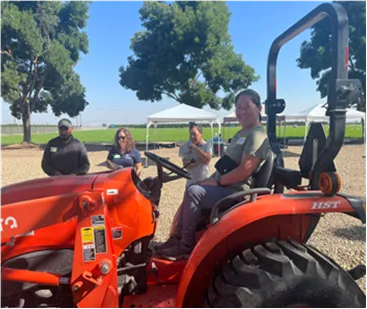Introduction
This program was launched in 2019 by the Fresno Small Farms Program, this pilot aimed to address infrastructure gaps in the California Department of Food and Agriculture’s (CDFA) Healthy Soils Program (HSP) by providing small farmers with necessary equipment for compost application and cover crop planting. This article discuss about the challenges, program impact and key lessons learned during the pilot program along with recommendations.
Challenges Identified
- Initial Barriers: Small-acreage farmers struggled with the high cost of commercial compost spreading services, and rental equipment posed logistical and financial challenges.
- Equipment Purchase and Coordination: While purchasing equipment, including a compost spreader and front loader, resolved many issues, logistical planning remained complex. Coordination of multiple equipment needs on the same day led to scheduling difficulties.
- Technical and Operational Barriers: Issues like equipment compatibility, missing parts, and unfamiliarity with new machinery resulted in delays and repair costs. The “regen” button on tractors caused frequent operational disruptions.
- Security Issues: Theft of equipment, including a tractor, underscored the need for better security measures, such as GPS tracking and safe storage.
Program Impact
- Positive Outcomes: Farmers reported increased confidence in using composting equipment. The program served as a steppingstone for future grant applications and inspired one farmer to purchase their own compost spreader.
- Community Engagement: The initiative strengthened ties with local organizations and expanded awareness about composting within the community.

KEY LESSONS
Farmer Engagement: Direct communication and training were essential. Many growers, especially first-time users, required hands-on demonstrations to ensure safe and effective equipment use.
Scheduling and Staff Management: Coordination of equipment availability was challenging due to farmers’ time constraints. A scheduling system and dedicated manager helped streamline operations.
- Equipment Maintenance: The need for regular maintenance, training, and clear protocols for equipment handling became evident. Staff time and resource allocation were also stretched thin.
Recommendations
- For the California Department of Food and Agriculture (CDFA): Increase compost payment rates for small farms, simplify reporting requirements, and allow more flexible compost delivery options.
- Operational Improvements: Streamline the equipment loan process, increase staff support, and enhance security measures for equipment storage.
- Program Expansion: Consider broader application of this model across the state, with adjustments based on lessons learned.
Conclusion
The Small Farms Fresno Equipment Sharing Pilot Program has demonstrated the potential of collaborative, community-driven solutions in addressing critical infrastructure gaps faced by small-scale farmers across California. By sharing the outcomes and mistakes from this program, the Fresno small farms program, successfully sparked interest across California.
From legislation to implementing field-realities, this pilot has laid the groundwork for a sustainable model to address long-standing equipment access barriers for small farmers in California. This pilot is not the end—it is the beginning of a broader movement toward equity, resilience, and sustainability for California’s socially disadvantage small-scaled farmers.
The future of the program has now been supported through the F3 innovate Farming Food Future Program. While the Small Farms Team provides vital leadership in developing SOPs, guiding non-technical staff through equipment procurement processes, and documenting key lessons learned. This expanded the program’s geographic and organizational reach, resulting in increased equipment availability and strengthened support.
